Economics and Finance for Business
VerifiedAdded on 2023/06/03
|12
|3983
|135
AI Summary
This report analyses and compares the growth, pricing and non-pricing strategies of Mc Donald’s and Hungry Jack’s in Sydney CBD Townhall area. It also examines the opportunities which these companies can exploit in the concerned market.
Contribute Materials
Your contribution can guide someone’s learning journey. Share your
documents today.
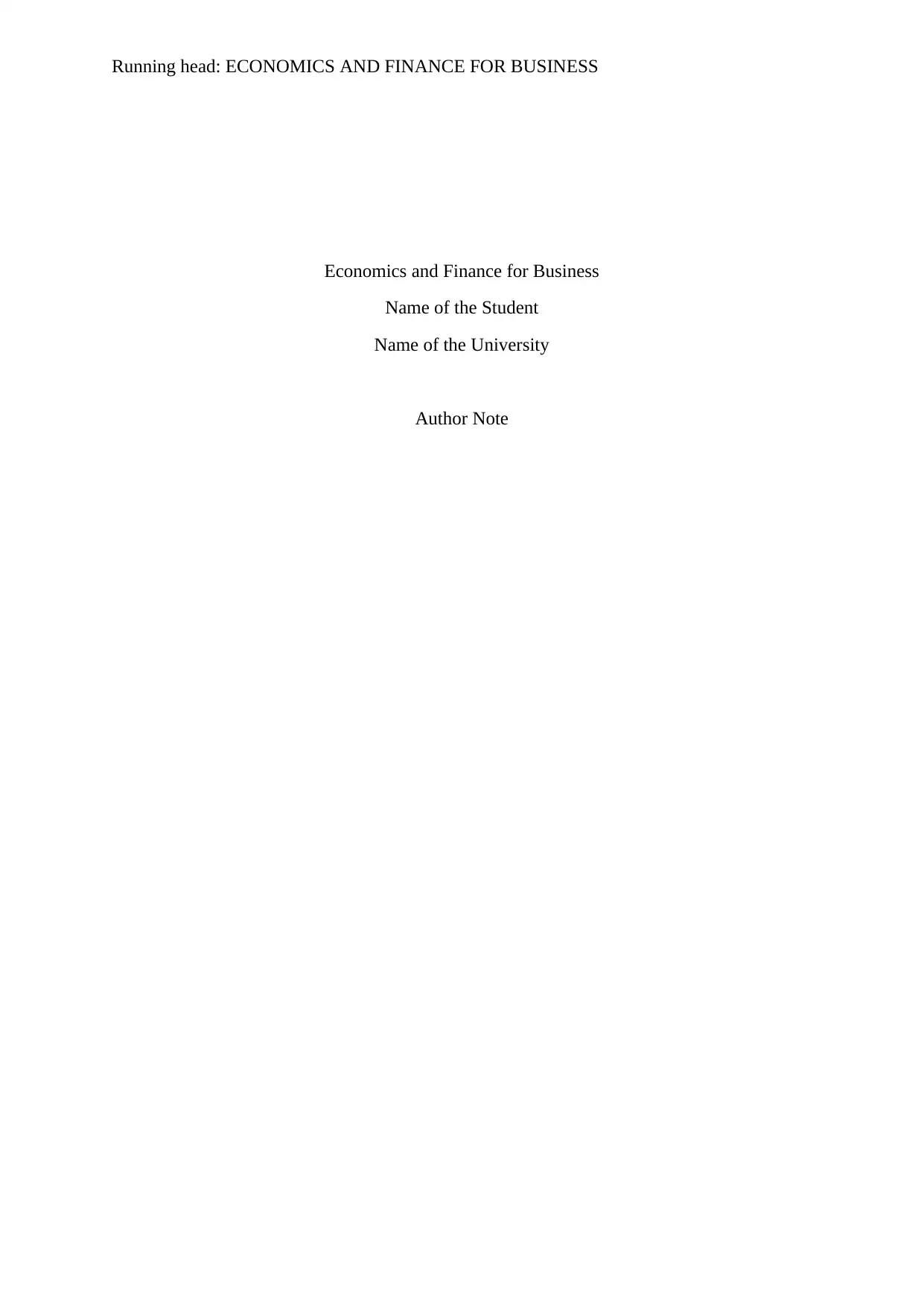
Running head: ECONOMICS AND FINANCE FOR BUSINESS
Economics and Finance for Business
Name of the Student
Name of the University
Author Note
Economics and Finance for Business
Name of the Student
Name of the University
Author Note
Secure Best Marks with AI Grader
Need help grading? Try our AI Grader for instant feedback on your assignments.
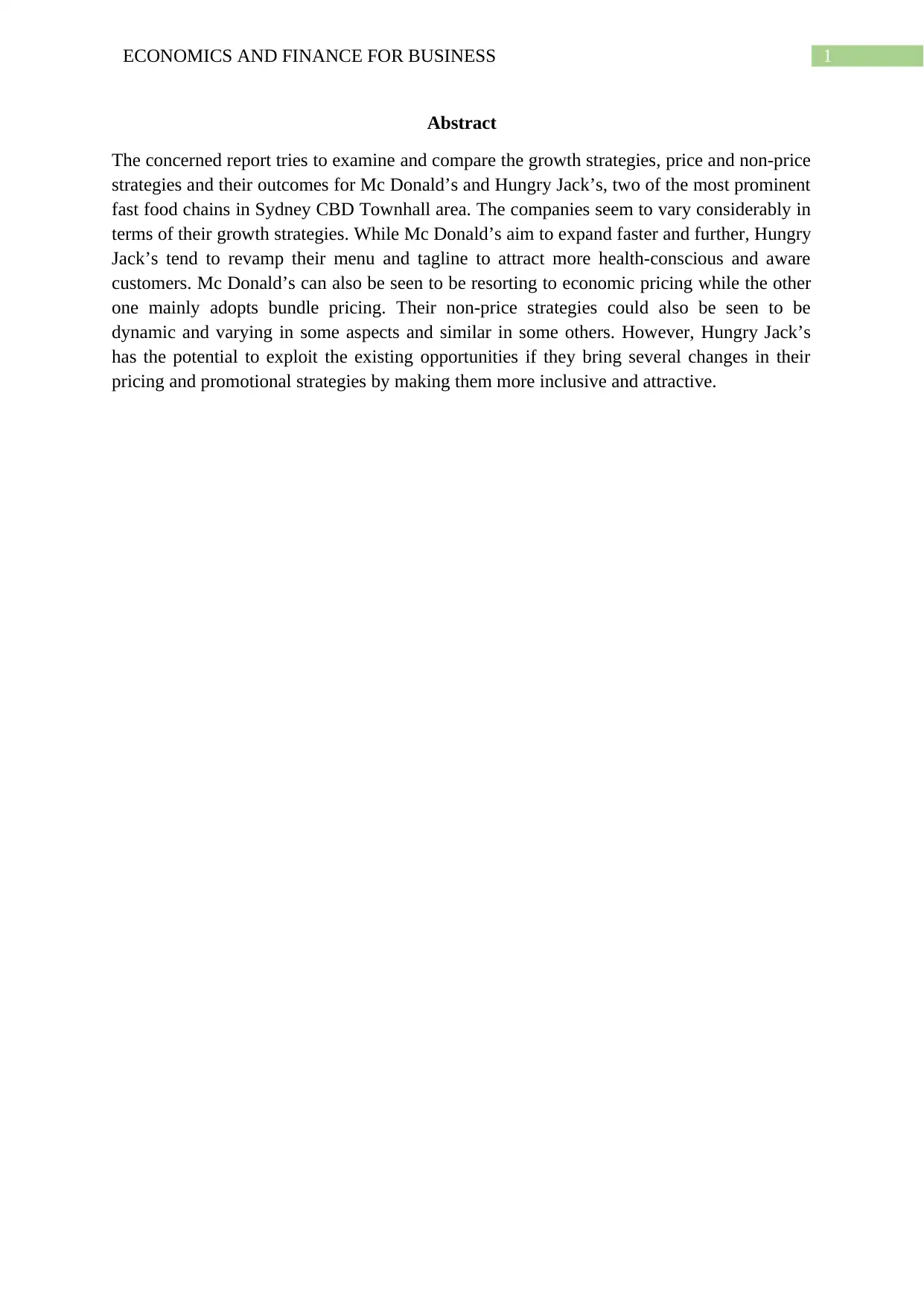
1ECONOMICS AND FINANCE FOR BUSINESS
Abstract
The concerned report tries to examine and compare the growth strategies, price and non-price
strategies and their outcomes for Mc Donald’s and Hungry Jack’s, two of the most prominent
fast food chains in Sydney CBD Townhall area. The companies seem to vary considerably in
terms of their growth strategies. While Mc Donald’s aim to expand faster and further, Hungry
Jack’s tend to revamp their menu and tagline to attract more health-conscious and aware
customers. Mc Donald’s can also be seen to be resorting to economic pricing while the other
one mainly adopts bundle pricing. Their non-price strategies could also be seen to be
dynamic and varying in some aspects and similar in some others. However, Hungry Jack’s
has the potential to exploit the existing opportunities if they bring several changes in their
pricing and promotional strategies by making them more inclusive and attractive.
Abstract
The concerned report tries to examine and compare the growth strategies, price and non-price
strategies and their outcomes for Mc Donald’s and Hungry Jack’s, two of the most prominent
fast food chains in Sydney CBD Townhall area. The companies seem to vary considerably in
terms of their growth strategies. While Mc Donald’s aim to expand faster and further, Hungry
Jack’s tend to revamp their menu and tagline to attract more health-conscious and aware
customers. Mc Donald’s can also be seen to be resorting to economic pricing while the other
one mainly adopts bundle pricing. Their non-price strategies could also be seen to be
dynamic and varying in some aspects and similar in some others. However, Hungry Jack’s
has the potential to exploit the existing opportunities if they bring several changes in their
pricing and promotional strategies by making them more inclusive and attractive.
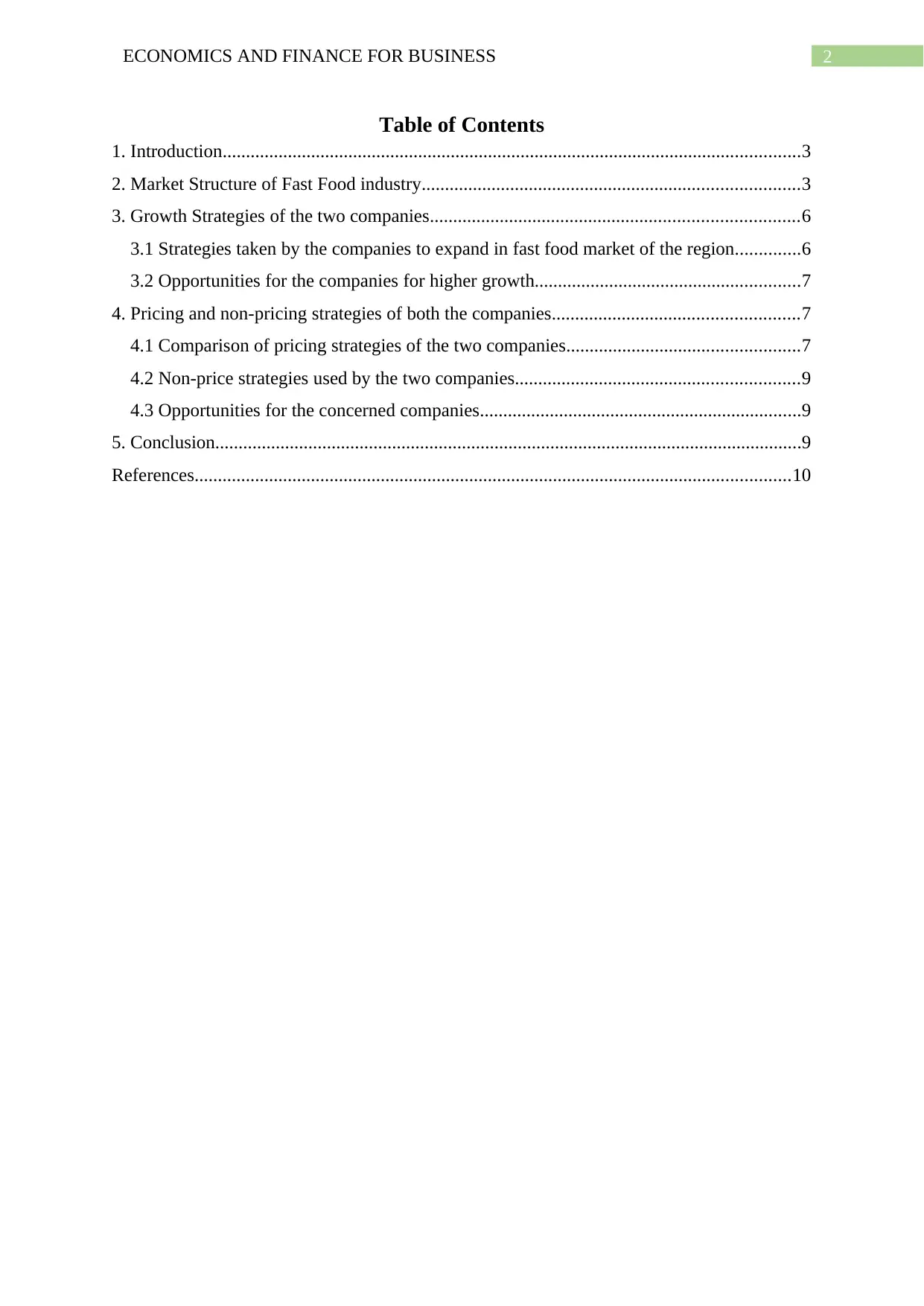
2ECONOMICS AND FINANCE FOR BUSINESS
Table of Contents
1. Introduction............................................................................................................................3
2. Market Structure of Fast Food industry.................................................................................3
3. Growth Strategies of the two companies...............................................................................6
3.1 Strategies taken by the companies to expand in fast food market of the region..............6
3.2 Opportunities for the companies for higher growth.........................................................7
4. Pricing and non-pricing strategies of both the companies.....................................................7
4.1 Comparison of pricing strategies of the two companies..................................................7
4.2 Non-price strategies used by the two companies.............................................................9
4.3 Opportunities for the concerned companies.....................................................................9
5. Conclusion..............................................................................................................................9
References................................................................................................................................10
Table of Contents
1. Introduction............................................................................................................................3
2. Market Structure of Fast Food industry.................................................................................3
3. Growth Strategies of the two companies...............................................................................6
3.1 Strategies taken by the companies to expand in fast food market of the region..............6
3.2 Opportunities for the companies for higher growth.........................................................7
4. Pricing and non-pricing strategies of both the companies.....................................................7
4.1 Comparison of pricing strategies of the two companies..................................................7
4.2 Non-price strategies used by the two companies.............................................................9
4.3 Opportunities for the concerned companies.....................................................................9
5. Conclusion..............................................................................................................................9
References................................................................................................................................10
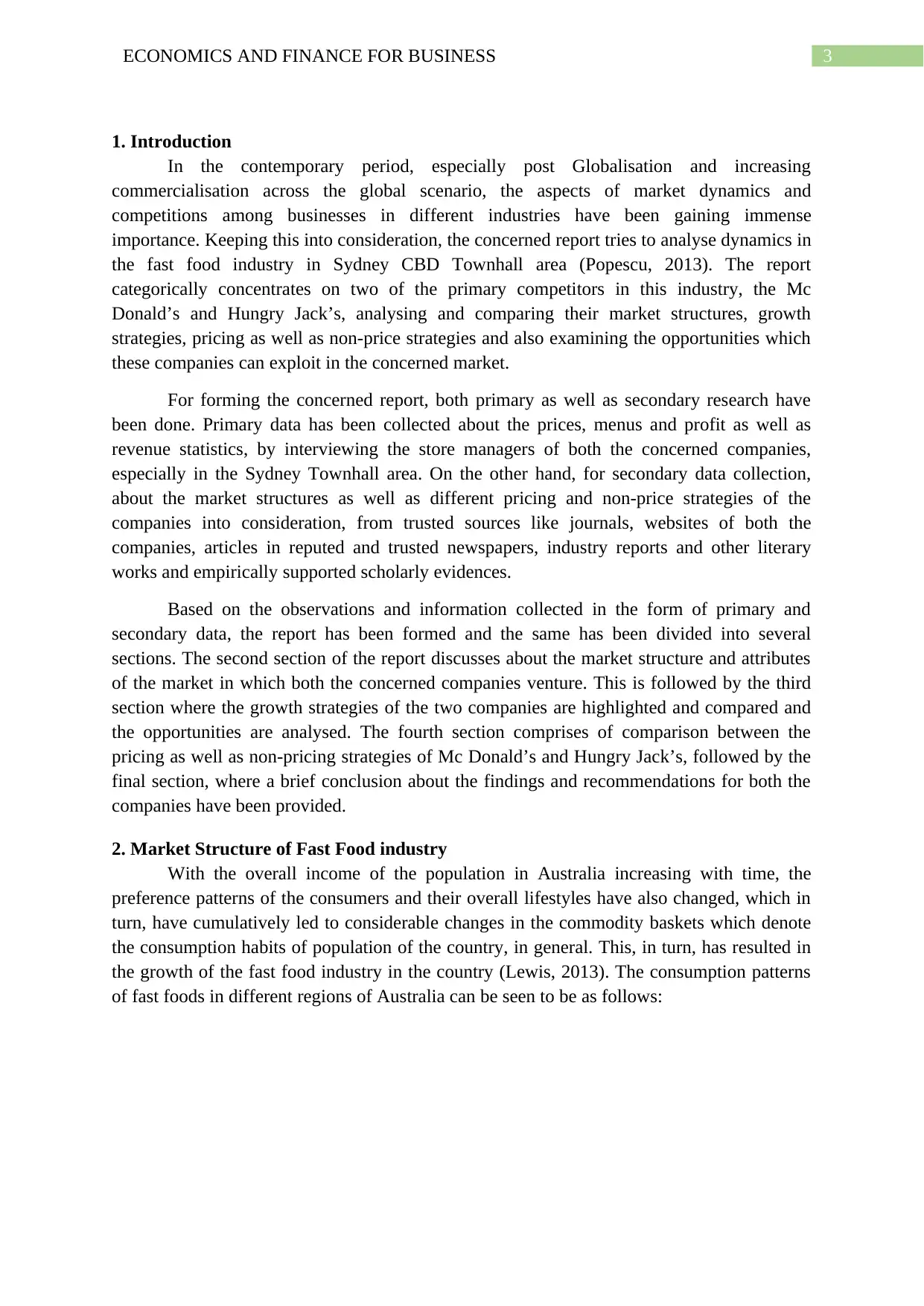
3ECONOMICS AND FINANCE FOR BUSINESS
1. Introduction
In the contemporary period, especially post Globalisation and increasing
commercialisation across the global scenario, the aspects of market dynamics and
competitions among businesses in different industries have been gaining immense
importance. Keeping this into consideration, the concerned report tries to analyse dynamics in
the fast food industry in Sydney CBD Townhall area (Popescu, 2013). The report
categorically concentrates on two of the primary competitors in this industry, the Mc
Donald’s and Hungry Jack’s, analysing and comparing their market structures, growth
strategies, pricing as well as non-price strategies and also examining the opportunities which
these companies can exploit in the concerned market.
For forming the concerned report, both primary as well as secondary research have
been done. Primary data has been collected about the prices, menus and profit as well as
revenue statistics, by interviewing the store managers of both the concerned companies,
especially in the Sydney Townhall area. On the other hand, for secondary data collection,
about the market structures as well as different pricing and non-price strategies of the
companies into consideration, from trusted sources like journals, websites of both the
companies, articles in reputed and trusted newspapers, industry reports and other literary
works and empirically supported scholarly evidences.
Based on the observations and information collected in the form of primary and
secondary data, the report has been formed and the same has been divided into several
sections. The second section of the report discusses about the market structure and attributes
of the market in which both the concerned companies venture. This is followed by the third
section where the growth strategies of the two companies are highlighted and compared and
the opportunities are analysed. The fourth section comprises of comparison between the
pricing as well as non-pricing strategies of Mc Donald’s and Hungry Jack’s, followed by the
final section, where a brief conclusion about the findings and recommendations for both the
companies have been provided.
2. Market Structure of Fast Food industry
With the overall income of the population in Australia increasing with time, the
preference patterns of the consumers and their overall lifestyles have also changed, which in
turn, have cumulatively led to considerable changes in the commodity baskets which denote
the consumption habits of population of the country, in general. This, in turn, has resulted in
the growth of the fast food industry in the country (Lewis, 2013). The consumption patterns
of fast foods in different regions of Australia can be seen to be as follows:
1. Introduction
In the contemporary period, especially post Globalisation and increasing
commercialisation across the global scenario, the aspects of market dynamics and
competitions among businesses in different industries have been gaining immense
importance. Keeping this into consideration, the concerned report tries to analyse dynamics in
the fast food industry in Sydney CBD Townhall area (Popescu, 2013). The report
categorically concentrates on two of the primary competitors in this industry, the Mc
Donald’s and Hungry Jack’s, analysing and comparing their market structures, growth
strategies, pricing as well as non-price strategies and also examining the opportunities which
these companies can exploit in the concerned market.
For forming the concerned report, both primary as well as secondary research have
been done. Primary data has been collected about the prices, menus and profit as well as
revenue statistics, by interviewing the store managers of both the concerned companies,
especially in the Sydney Townhall area. On the other hand, for secondary data collection,
about the market structures as well as different pricing and non-price strategies of the
companies into consideration, from trusted sources like journals, websites of both the
companies, articles in reputed and trusted newspapers, industry reports and other literary
works and empirically supported scholarly evidences.
Based on the observations and information collected in the form of primary and
secondary data, the report has been formed and the same has been divided into several
sections. The second section of the report discusses about the market structure and attributes
of the market in which both the concerned companies venture. This is followed by the third
section where the growth strategies of the two companies are highlighted and compared and
the opportunities are analysed. The fourth section comprises of comparison between the
pricing as well as non-pricing strategies of Mc Donald’s and Hungry Jack’s, followed by the
final section, where a brief conclusion about the findings and recommendations for both the
companies have been provided.
2. Market Structure of Fast Food industry
With the overall income of the population in Australia increasing with time, the
preference patterns of the consumers and their overall lifestyles have also changed, which in
turn, have cumulatively led to considerable changes in the commodity baskets which denote
the consumption habits of population of the country, in general. This, in turn, has resulted in
the growth of the fast food industry in the country (Lewis, 2013). The consumption patterns
of fast foods in different regions of Australia can be seen to be as follows:
Secure Best Marks with AI Grader
Need help grading? Try our AI Grader for instant feedback on your assignments.
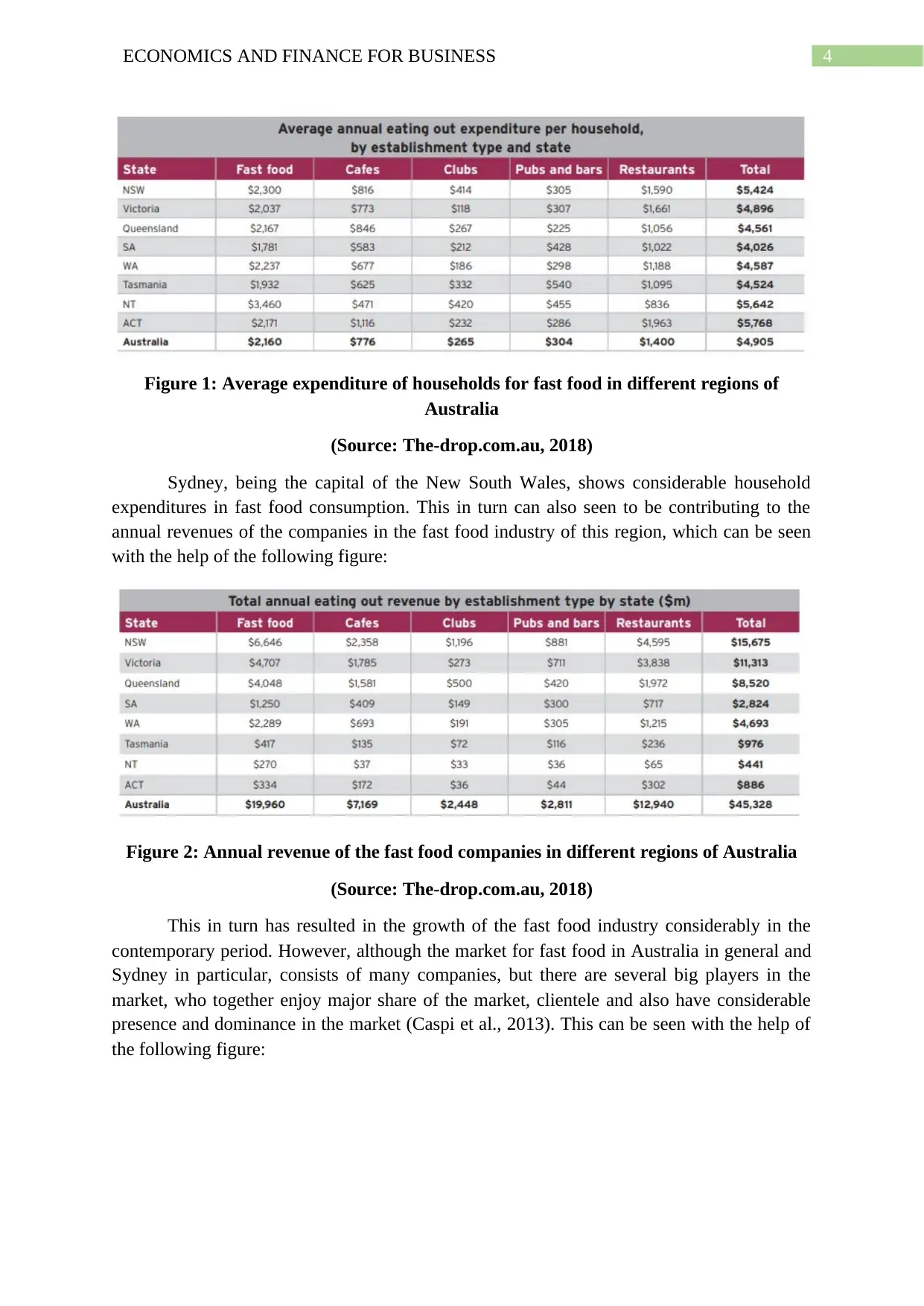
4ECONOMICS AND FINANCE FOR BUSINESS
Figure 1: Average expenditure of households for fast food in different regions of
Australia
(Source: The-drop.com.au, 2018)
Sydney, being the capital of the New South Wales, shows considerable household
expenditures in fast food consumption. This in turn can also seen to be contributing to the
annual revenues of the companies in the fast food industry of this region, which can be seen
with the help of the following figure:
Figure 2: Annual revenue of the fast food companies in different regions of Australia
(Source: The-drop.com.au, 2018)
This in turn has resulted in the growth of the fast food industry considerably in the
contemporary period. However, although the market for fast food in Australia in general and
Sydney in particular, consists of many companies, but there are several big players in the
market, who together enjoy major share of the market, clientele and also have considerable
presence and dominance in the market (Caspi et al., 2013). This can be seen with the help of
the following figure:
Figure 1: Average expenditure of households for fast food in different regions of
Australia
(Source: The-drop.com.au, 2018)
Sydney, being the capital of the New South Wales, shows considerable household
expenditures in fast food consumption. This in turn can also seen to be contributing to the
annual revenues of the companies in the fast food industry of this region, which can be seen
with the help of the following figure:
Figure 2: Annual revenue of the fast food companies in different regions of Australia
(Source: The-drop.com.au, 2018)
This in turn has resulted in the growth of the fast food industry considerably in the
contemporary period. However, although the market for fast food in Australia in general and
Sydney in particular, consists of many companies, but there are several big players in the
market, who together enjoy major share of the market, clientele and also have considerable
presence and dominance in the market (Caspi et al., 2013). This can be seen with the help of
the following figure:
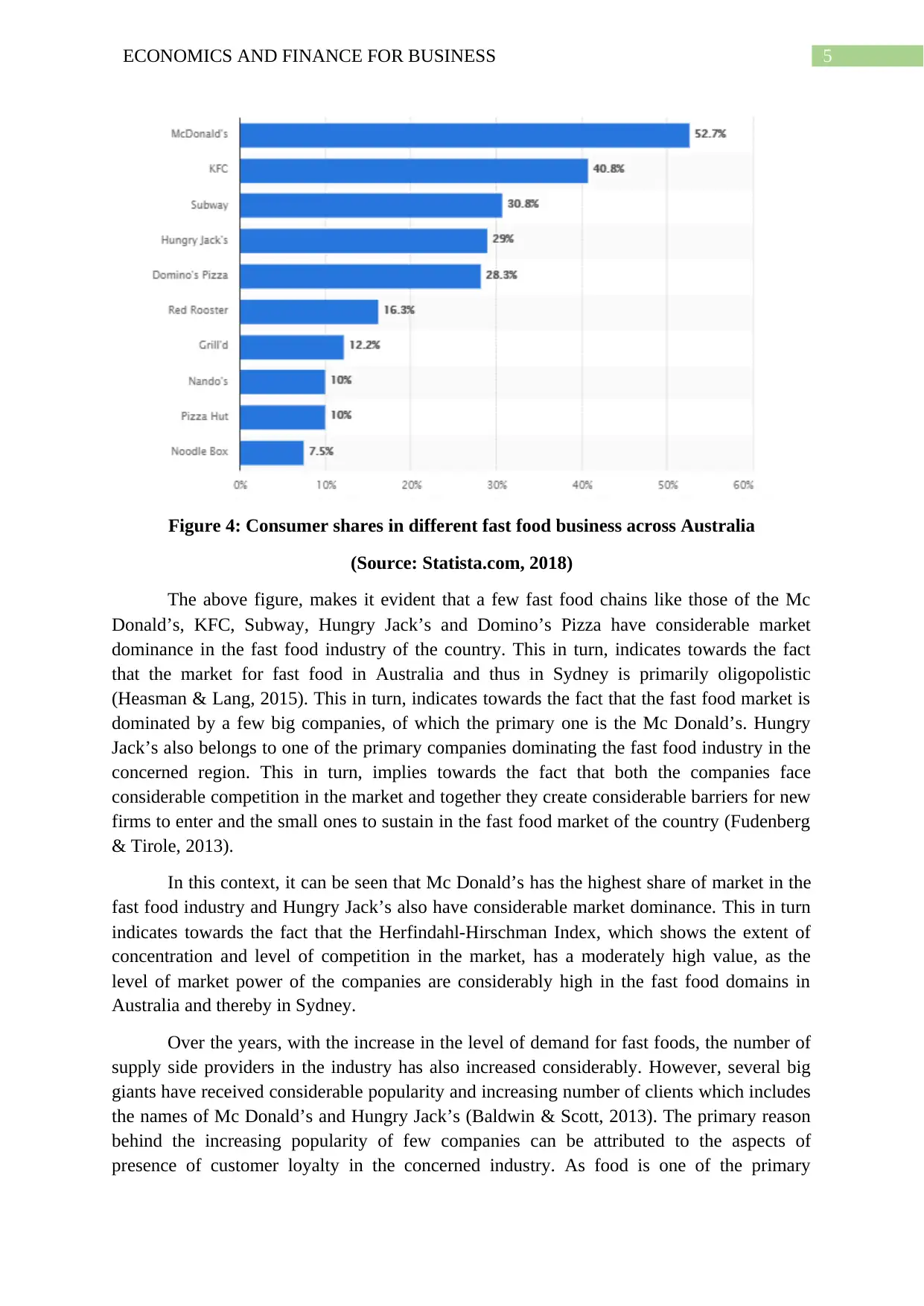
5ECONOMICS AND FINANCE FOR BUSINESS
Figure 4: Consumer shares in different fast food business across Australia
(Source: Statista.com, 2018)
The above figure, makes it evident that a few fast food chains like those of the Mc
Donald’s, KFC, Subway, Hungry Jack’s and Domino’s Pizza have considerable market
dominance in the fast food industry of the country. This in turn, indicates towards the fact
that the market for fast food in Australia and thus in Sydney is primarily oligopolistic
(Heasman & Lang, 2015). This in turn, indicates towards the fact that the fast food market is
dominated by a few big companies, of which the primary one is the Mc Donald’s. Hungry
Jack’s also belongs to one of the primary companies dominating the fast food industry in the
concerned region. This in turn, implies towards the fact that both the companies face
considerable competition in the market and together they create considerable barriers for new
firms to enter and the small ones to sustain in the fast food market of the country (Fudenberg
& Tirole, 2013).
In this context, it can be seen that Mc Donald’s has the highest share of market in the
fast food industry and Hungry Jack’s also have considerable market dominance. This in turn
indicates towards the fact that the Herfindahl-Hirschman Index, which shows the extent of
concentration and level of competition in the market, has a moderately high value, as the
level of market power of the companies are considerably high in the fast food domains in
Australia and thereby in Sydney.
Over the years, with the increase in the level of demand for fast foods, the number of
supply side providers in the industry has also increased considerably. However, several big
giants have received considerable popularity and increasing number of clients which includes
the names of Mc Donald’s and Hungry Jack’s (Baldwin & Scott, 2013). The primary reason
behind the increasing popularity of few companies can be attributed to the aspects of
presence of customer loyalty in the concerned industry. As food is one of the primary
Figure 4: Consumer shares in different fast food business across Australia
(Source: Statista.com, 2018)
The above figure, makes it evident that a few fast food chains like those of the Mc
Donald’s, KFC, Subway, Hungry Jack’s and Domino’s Pizza have considerable market
dominance in the fast food industry of the country. This in turn, indicates towards the fact
that the market for fast food in Australia and thus in Sydney is primarily oligopolistic
(Heasman & Lang, 2015). This in turn, indicates towards the fact that the fast food market is
dominated by a few big companies, of which the primary one is the Mc Donald’s. Hungry
Jack’s also belongs to one of the primary companies dominating the fast food industry in the
concerned region. This in turn, implies towards the fact that both the companies face
considerable competition in the market and together they create considerable barriers for new
firms to enter and the small ones to sustain in the fast food market of the country (Fudenberg
& Tirole, 2013).
In this context, it can be seen that Mc Donald’s has the highest share of market in the
fast food industry and Hungry Jack’s also have considerable market dominance. This in turn
indicates towards the fact that the Herfindahl-Hirschman Index, which shows the extent of
concentration and level of competition in the market, has a moderately high value, as the
level of market power of the companies are considerably high in the fast food domains in
Australia and thereby in Sydney.
Over the years, with the increase in the level of demand for fast foods, the number of
supply side providers in the industry has also increased considerably. However, several big
giants have received considerable popularity and increasing number of clients which includes
the names of Mc Donald’s and Hungry Jack’s (Baldwin & Scott, 2013). The primary reason
behind the increasing popularity of few companies can be attributed to the aspects of
presence of customer loyalty in the concerned industry. As food is one of the primary
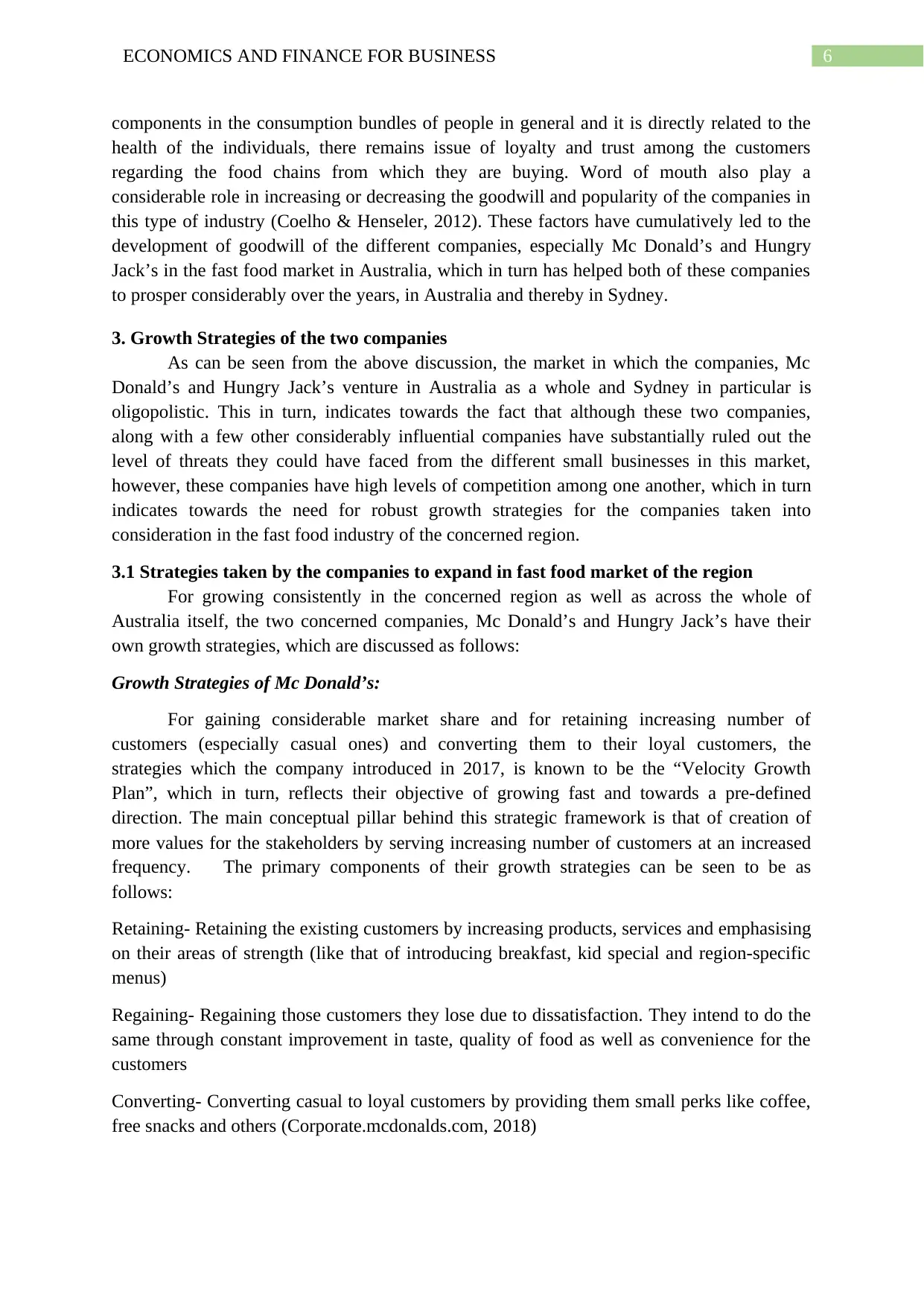
6ECONOMICS AND FINANCE FOR BUSINESS
components in the consumption bundles of people in general and it is directly related to the
health of the individuals, there remains issue of loyalty and trust among the customers
regarding the food chains from which they are buying. Word of mouth also play a
considerable role in increasing or decreasing the goodwill and popularity of the companies in
this type of industry (Coelho & Henseler, 2012). These factors have cumulatively led to the
development of goodwill of the different companies, especially Mc Donald’s and Hungry
Jack’s in the fast food market in Australia, which in turn has helped both of these companies
to prosper considerably over the years, in Australia and thereby in Sydney.
3. Growth Strategies of the two companies
As can be seen from the above discussion, the market in which the companies, Mc
Donald’s and Hungry Jack’s venture in Australia as a whole and Sydney in particular is
oligopolistic. This in turn, indicates towards the fact that although these two companies,
along with a few other considerably influential companies have substantially ruled out the
level of threats they could have faced from the different small businesses in this market,
however, these companies have high levels of competition among one another, which in turn
indicates towards the need for robust growth strategies for the companies taken into
consideration in the fast food industry of the concerned region.
3.1 Strategies taken by the companies to expand in fast food market of the region
For growing consistently in the concerned region as well as across the whole of
Australia itself, the two concerned companies, Mc Donald’s and Hungry Jack’s have their
own growth strategies, which are discussed as follows:
Growth Strategies of Mc Donald’s:
For gaining considerable market share and for retaining increasing number of
customers (especially casual ones) and converting them to their loyal customers, the
strategies which the company introduced in 2017, is known to be the “Velocity Growth
Plan”, which in turn, reflects their objective of growing fast and towards a pre-defined
direction. The main conceptual pillar behind this strategic framework is that of creation of
more values for the stakeholders by serving increasing number of customers at an increased
frequency. The primary components of their growth strategies can be seen to be as
follows:
Retaining- Retaining the existing customers by increasing products, services and emphasising
on their areas of strength (like that of introducing breakfast, kid special and region-specific
menus)
Regaining- Regaining those customers they lose due to dissatisfaction. They intend to do the
same through constant improvement in taste, quality of food as well as convenience for the
customers
Converting- Converting casual to loyal customers by providing them small perks like coffee,
free snacks and others (Corporate.mcdonalds.com, 2018)
components in the consumption bundles of people in general and it is directly related to the
health of the individuals, there remains issue of loyalty and trust among the customers
regarding the food chains from which they are buying. Word of mouth also play a
considerable role in increasing or decreasing the goodwill and popularity of the companies in
this type of industry (Coelho & Henseler, 2012). These factors have cumulatively led to the
development of goodwill of the different companies, especially Mc Donald’s and Hungry
Jack’s in the fast food market in Australia, which in turn has helped both of these companies
to prosper considerably over the years, in Australia and thereby in Sydney.
3. Growth Strategies of the two companies
As can be seen from the above discussion, the market in which the companies, Mc
Donald’s and Hungry Jack’s venture in Australia as a whole and Sydney in particular is
oligopolistic. This in turn, indicates towards the fact that although these two companies,
along with a few other considerably influential companies have substantially ruled out the
level of threats they could have faced from the different small businesses in this market,
however, these companies have high levels of competition among one another, which in turn
indicates towards the need for robust growth strategies for the companies taken into
consideration in the fast food industry of the concerned region.
3.1 Strategies taken by the companies to expand in fast food market of the region
For growing consistently in the concerned region as well as across the whole of
Australia itself, the two concerned companies, Mc Donald’s and Hungry Jack’s have their
own growth strategies, which are discussed as follows:
Growth Strategies of Mc Donald’s:
For gaining considerable market share and for retaining increasing number of
customers (especially casual ones) and converting them to their loyal customers, the
strategies which the company introduced in 2017, is known to be the “Velocity Growth
Plan”, which in turn, reflects their objective of growing fast and towards a pre-defined
direction. The main conceptual pillar behind this strategic framework is that of creation of
more values for the stakeholders by serving increasing number of customers at an increased
frequency. The primary components of their growth strategies can be seen to be as
follows:
Retaining- Retaining the existing customers by increasing products, services and emphasising
on their areas of strength (like that of introducing breakfast, kid special and region-specific
menus)
Regaining- Regaining those customers they lose due to dissatisfaction. They intend to do the
same through constant improvement in taste, quality of food as well as convenience for the
customers
Converting- Converting casual to loyal customers by providing them small perks like coffee,
free snacks and others (Corporate.mcdonalds.com, 2018)
Paraphrase This Document
Need a fresh take? Get an instant paraphrase of this document with our AI Paraphraser

7ECONOMICS AND FINANCE FOR BUSINESS
Thus, from the conceptual point of view the growth strategies adopted by Mc
Donald’s mainly show the attributes of product and market diversification, new product
development as well as horizontal growth trends. The strategies are supported by the
competitive advantage which the company already enjoys and add value to their core
competencies (Wright & Stigliani, 2013).
Growth Strategies of Hungry Jack’s
One of the primary changes in the growth strategies of Hungry Jack’s, in Australia
(thereby in Sydney) in the recent period, is that of changing their sixteen-year-old tagline to
“Hungry Jack’s makes it better” from “The burgers are better at Hungry Jack’s”. The primary
working notion behind the same has been to attract the increasing share of health-conscious
customers in the concerned regions, who emphasise on the tastes as well as the health
quotient of the food prepared by them (Marketingmag.com.au, 2018). With increasing
awareness regarding obesity and harmful effects, the concerned company has been revamping
its menu and the cooking process, to inflict a feeling among their customers that they care
about the health of their customers.
This, in terms of the theoretical framework of growth strategies can be seen to be
showing the traits of diversification and market penetration not only in terms of new products
but also in terms of attracting new and different clientele (health-conscious and aware ones),
which tend to increase in Sydney with time.
3.2 Opportunities for the companies for higher growth
Both the concerned companies have been decently growing in Australia as a whole
and in Sydney in particular over the years. However, the fast expansion and product
diversification in terms of taste, variations and different customer demographics can be seen
to be benefitting Mc Donald’s more compared to the strategies taken by Hungry Jack’s as it
has been solely emphasising in attracting health-conscious customers. The latter can
however, exploit the opportunities of increasing customers in the market, by making their
products more diversified age-wise and according to diverse preferences of different types of
customers as solely depending on one type of new customers can prove to be risky for
Hungry Jack’s.
4. Pricing and non-pricing strategies of both the companies
As discussed in the previous sections, venturing in an oligopolistic fast food market,
both the concerned companies, the Mc Donald’s and the Hungry Jack’s are competitors of
one another, consistently striving to earn more clientele, revenue and profitability as well as
competitive edge over one another. The companies compete both in terms of pricing and non-
price strategies, which, based on the primary as well as secondary data collected, are
compared and analysed in this section.
4.1 Comparison of pricing strategies of the two companies
To analyse and compare the pricing strategies of Mc Donald’s vis-à-vis Hungry
Jack’s in the concerned region, the prices of similar products sold by the two companies are
shown in the following table, based on the primary data collected in this aspect:
Thus, from the conceptual point of view the growth strategies adopted by Mc
Donald’s mainly show the attributes of product and market diversification, new product
development as well as horizontal growth trends. The strategies are supported by the
competitive advantage which the company already enjoys and add value to their core
competencies (Wright & Stigliani, 2013).
Growth Strategies of Hungry Jack’s
One of the primary changes in the growth strategies of Hungry Jack’s, in Australia
(thereby in Sydney) in the recent period, is that of changing their sixteen-year-old tagline to
“Hungry Jack’s makes it better” from “The burgers are better at Hungry Jack’s”. The primary
working notion behind the same has been to attract the increasing share of health-conscious
customers in the concerned regions, who emphasise on the tastes as well as the health
quotient of the food prepared by them (Marketingmag.com.au, 2018). With increasing
awareness regarding obesity and harmful effects, the concerned company has been revamping
its menu and the cooking process, to inflict a feeling among their customers that they care
about the health of their customers.
This, in terms of the theoretical framework of growth strategies can be seen to be
showing the traits of diversification and market penetration not only in terms of new products
but also in terms of attracting new and different clientele (health-conscious and aware ones),
which tend to increase in Sydney with time.
3.2 Opportunities for the companies for higher growth
Both the concerned companies have been decently growing in Australia as a whole
and in Sydney in particular over the years. However, the fast expansion and product
diversification in terms of taste, variations and different customer demographics can be seen
to be benefitting Mc Donald’s more compared to the strategies taken by Hungry Jack’s as it
has been solely emphasising in attracting health-conscious customers. The latter can
however, exploit the opportunities of increasing customers in the market, by making their
products more diversified age-wise and according to diverse preferences of different types of
customers as solely depending on one type of new customers can prove to be risky for
Hungry Jack’s.
4. Pricing and non-pricing strategies of both the companies
As discussed in the previous sections, venturing in an oligopolistic fast food market,
both the concerned companies, the Mc Donald’s and the Hungry Jack’s are competitors of
one another, consistently striving to earn more clientele, revenue and profitability as well as
competitive edge over one another. The companies compete both in terms of pricing and non-
price strategies, which, based on the primary as well as secondary data collected, are
compared and analysed in this section.
4.1 Comparison of pricing strategies of the two companies
To analyse and compare the pricing strategies of Mc Donald’s vis-à-vis Hungry
Jack’s in the concerned region, the prices of similar products sold by the two companies are
shown in the following table, based on the primary data collected in this aspect:
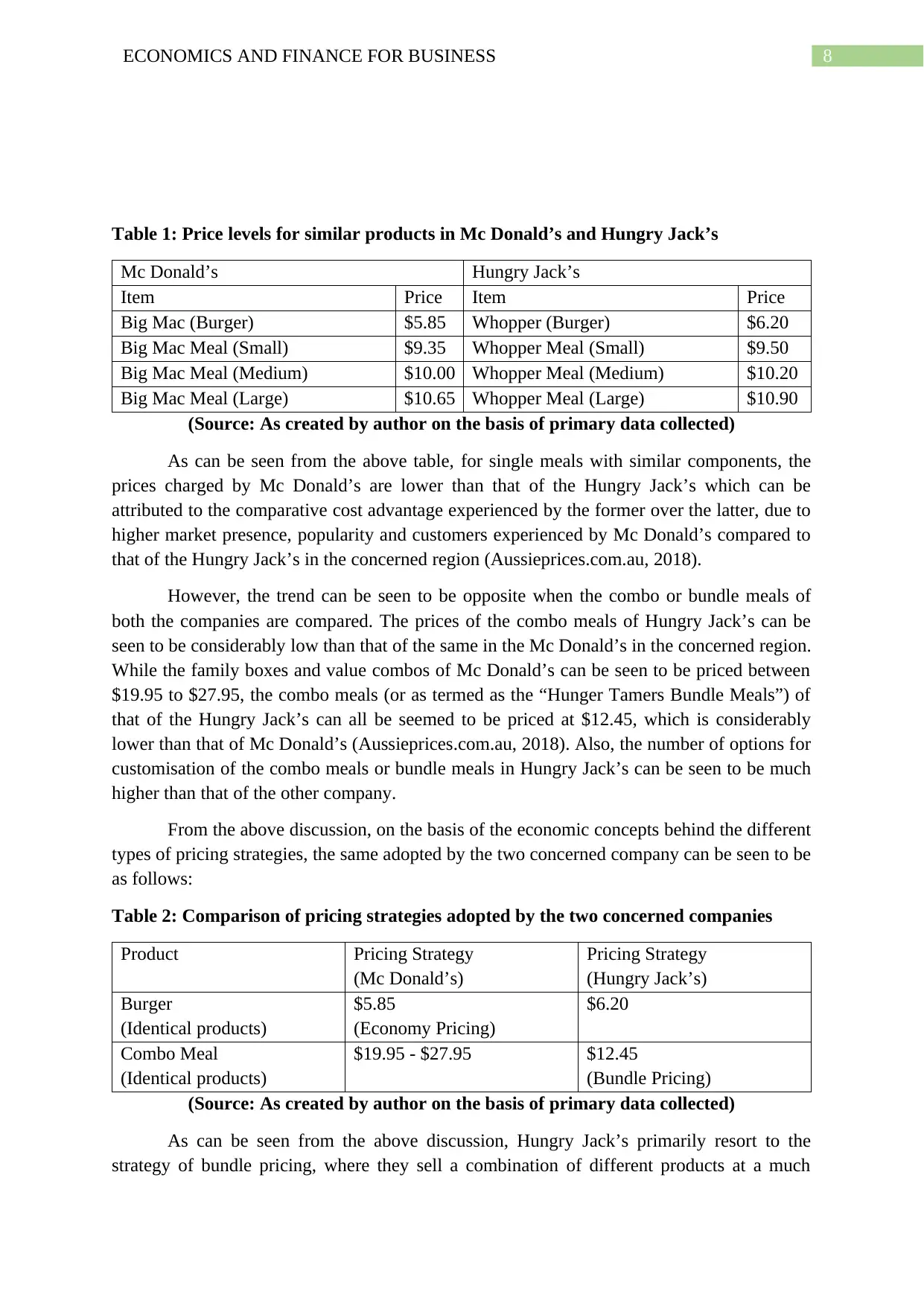
8ECONOMICS AND FINANCE FOR BUSINESS
Table 1: Price levels for similar products in Mc Donald’s and Hungry Jack’s
Mc Donald’s Hungry Jack’s
Item Price Item Price
Big Mac (Burger) $5.85 Whopper (Burger) $6.20
Big Mac Meal (Small) $9.35 Whopper Meal (Small) $9.50
Big Mac Meal (Medium) $10.00 Whopper Meal (Medium) $10.20
Big Mac Meal (Large) $10.65 Whopper Meal (Large) $10.90
(Source: As created by author on the basis of primary data collected)
As can be seen from the above table, for single meals with similar components, the
prices charged by Mc Donald’s are lower than that of the Hungry Jack’s which can be
attributed to the comparative cost advantage experienced by the former over the latter, due to
higher market presence, popularity and customers experienced by Mc Donald’s compared to
that of the Hungry Jack’s in the concerned region (Aussieprices.com.au, 2018).
However, the trend can be seen to be opposite when the combo or bundle meals of
both the companies are compared. The prices of the combo meals of Hungry Jack’s can be
seen to be considerably low than that of the same in the Mc Donald’s in the concerned region.
While the family boxes and value combos of Mc Donald’s can be seen to be priced between
$19.95 to $27.95, the combo meals (or as termed as the “Hunger Tamers Bundle Meals”) of
that of the Hungry Jack’s can all be seemed to be priced at $12.45, which is considerably
lower than that of Mc Donald’s (Aussieprices.com.au, 2018). Also, the number of options for
customisation of the combo meals or bundle meals in Hungry Jack’s can be seen to be much
higher than that of the other company.
From the above discussion, on the basis of the economic concepts behind the different
types of pricing strategies, the same adopted by the two concerned company can be seen to be
as follows:
Table 2: Comparison of pricing strategies adopted by the two concerned companies
Product Pricing Strategy
(Mc Donald’s)
Pricing Strategy
(Hungry Jack’s)
Burger
(Identical products)
$5.85
(Economy Pricing)
$6.20
Combo Meal
(Identical products)
$19.95 - $27.95 $12.45
(Bundle Pricing)
(Source: As created by author on the basis of primary data collected)
As can be seen from the above discussion, Hungry Jack’s primarily resort to the
strategy of bundle pricing, where they sell a combination of different products at a much
Table 1: Price levels for similar products in Mc Donald’s and Hungry Jack’s
Mc Donald’s Hungry Jack’s
Item Price Item Price
Big Mac (Burger) $5.85 Whopper (Burger) $6.20
Big Mac Meal (Small) $9.35 Whopper Meal (Small) $9.50
Big Mac Meal (Medium) $10.00 Whopper Meal (Medium) $10.20
Big Mac Meal (Large) $10.65 Whopper Meal (Large) $10.90
(Source: As created by author on the basis of primary data collected)
As can be seen from the above table, for single meals with similar components, the
prices charged by Mc Donald’s are lower than that of the Hungry Jack’s which can be
attributed to the comparative cost advantage experienced by the former over the latter, due to
higher market presence, popularity and customers experienced by Mc Donald’s compared to
that of the Hungry Jack’s in the concerned region (Aussieprices.com.au, 2018).
However, the trend can be seen to be opposite when the combo or bundle meals of
both the companies are compared. The prices of the combo meals of Hungry Jack’s can be
seen to be considerably low than that of the same in the Mc Donald’s in the concerned region.
While the family boxes and value combos of Mc Donald’s can be seen to be priced between
$19.95 to $27.95, the combo meals (or as termed as the “Hunger Tamers Bundle Meals”) of
that of the Hungry Jack’s can all be seemed to be priced at $12.45, which is considerably
lower than that of Mc Donald’s (Aussieprices.com.au, 2018). Also, the number of options for
customisation of the combo meals or bundle meals in Hungry Jack’s can be seen to be much
higher than that of the other company.
From the above discussion, on the basis of the economic concepts behind the different
types of pricing strategies, the same adopted by the two concerned company can be seen to be
as follows:
Table 2: Comparison of pricing strategies adopted by the two concerned companies
Product Pricing Strategy
(Mc Donald’s)
Pricing Strategy
(Hungry Jack’s)
Burger
(Identical products)
$5.85
(Economy Pricing)
$6.20
Combo Meal
(Identical products)
$19.95 - $27.95 $12.45
(Bundle Pricing)
(Source: As created by author on the basis of primary data collected)
As can be seen from the above discussion, Hungry Jack’s primarily resort to the
strategy of bundle pricing, where they sell a combination of different products at a much
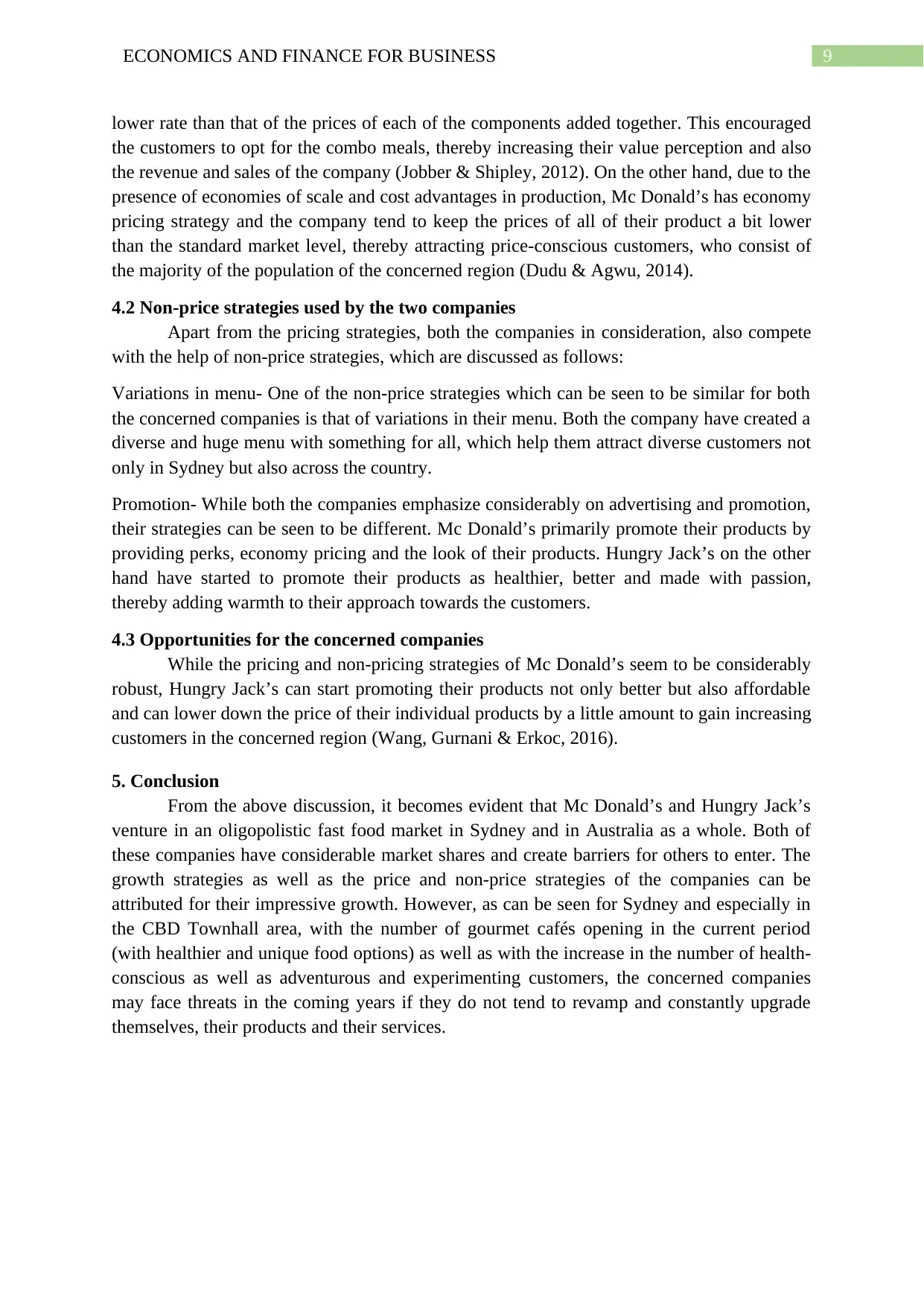
9ECONOMICS AND FINANCE FOR BUSINESS
lower rate than that of the prices of each of the components added together. This encouraged
the customers to opt for the combo meals, thereby increasing their value perception and also
the revenue and sales of the company (Jobber & Shipley, 2012). On the other hand, due to the
presence of economies of scale and cost advantages in production, Mc Donald’s has economy
pricing strategy and the company tend to keep the prices of all of their product a bit lower
than the standard market level, thereby attracting price-conscious customers, who consist of
the majority of the population of the concerned region (Dudu & Agwu, 2014).
4.2 Non-price strategies used by the two companies
Apart from the pricing strategies, both the companies in consideration, also compete
with the help of non-price strategies, which are discussed as follows:
Variations in menu- One of the non-price strategies which can be seen to be similar for both
the concerned companies is that of variations in their menu. Both the company have created a
diverse and huge menu with something for all, which help them attract diverse customers not
only in Sydney but also across the country.
Promotion- While both the companies emphasize considerably on advertising and promotion,
their strategies can be seen to be different. Mc Donald’s primarily promote their products by
providing perks, economy pricing and the look of their products. Hungry Jack’s on the other
hand have started to promote their products as healthier, better and made with passion,
thereby adding warmth to their approach towards the customers.
4.3 Opportunities for the concerned companies
While the pricing and non-pricing strategies of Mc Donald’s seem to be considerably
robust, Hungry Jack’s can start promoting their products not only better but also affordable
and can lower down the price of their individual products by a little amount to gain increasing
customers in the concerned region (Wang, Gurnani & Erkoc, 2016).
5. Conclusion
From the above discussion, it becomes evident that Mc Donald’s and Hungry Jack’s
venture in an oligopolistic fast food market in Sydney and in Australia as a whole. Both of
these companies have considerable market shares and create barriers for others to enter. The
growth strategies as well as the price and non-price strategies of the companies can be
attributed for their impressive growth. However, as can be seen for Sydney and especially in
the CBD Townhall area, with the number of gourmet cafés opening in the current period
(with healthier and unique food options) as well as with the increase in the number of health-
conscious as well as adventurous and experimenting customers, the concerned companies
may face threats in the coming years if they do not tend to revamp and constantly upgrade
themselves, their products and their services.
lower rate than that of the prices of each of the components added together. This encouraged
the customers to opt for the combo meals, thereby increasing their value perception and also
the revenue and sales of the company (Jobber & Shipley, 2012). On the other hand, due to the
presence of economies of scale and cost advantages in production, Mc Donald’s has economy
pricing strategy and the company tend to keep the prices of all of their product a bit lower
than the standard market level, thereby attracting price-conscious customers, who consist of
the majority of the population of the concerned region (Dudu & Agwu, 2014).
4.2 Non-price strategies used by the two companies
Apart from the pricing strategies, both the companies in consideration, also compete
with the help of non-price strategies, which are discussed as follows:
Variations in menu- One of the non-price strategies which can be seen to be similar for both
the concerned companies is that of variations in their menu. Both the company have created a
diverse and huge menu with something for all, which help them attract diverse customers not
only in Sydney but also across the country.
Promotion- While both the companies emphasize considerably on advertising and promotion,
their strategies can be seen to be different. Mc Donald’s primarily promote their products by
providing perks, economy pricing and the look of their products. Hungry Jack’s on the other
hand have started to promote their products as healthier, better and made with passion,
thereby adding warmth to their approach towards the customers.
4.3 Opportunities for the concerned companies
While the pricing and non-pricing strategies of Mc Donald’s seem to be considerably
robust, Hungry Jack’s can start promoting their products not only better but also affordable
and can lower down the price of their individual products by a little amount to gain increasing
customers in the concerned region (Wang, Gurnani & Erkoc, 2016).
5. Conclusion
From the above discussion, it becomes evident that Mc Donald’s and Hungry Jack’s
venture in an oligopolistic fast food market in Sydney and in Australia as a whole. Both of
these companies have considerable market shares and create barriers for others to enter. The
growth strategies as well as the price and non-price strategies of the companies can be
attributed for their impressive growth. However, as can be seen for Sydney and especially in
the CBD Townhall area, with the number of gourmet cafés opening in the current period
(with healthier and unique food options) as well as with the increase in the number of health-
conscious as well as adventurous and experimenting customers, the concerned companies
may face threats in the coming years if they do not tend to revamp and constantly upgrade
themselves, their products and their services.
Secure Best Marks with AI Grader
Need help grading? Try our AI Grader for instant feedback on your assignments.

10ECONOMICS AND FINANCE FOR BUSINESS
References
Aussieprices.com.au. (2018). Hungry Jack's Menu Prices - October 2018 - Aussie Prices.
Retrieved from https://www.aussieprices.com.au/food/fast-food/hungry-jacks-prices/
Aussieprices.com.au. (2018). McDonald's Menu Prices in Australia - October 2018 - Aussie
Prices. Retrieved from https://www.aussieprices.com.au/food/fast-food/mcdonalds-
prices/
Baldwin, W., & Scott, J. (2013). Market structure and technological change. Taylor &
Francis.
Caspi, C. E., Sorensen, G., Subramanian, S. V., & Kawachi, I. (2012). The local food
environment and diet: a systematic review. Health & place, 18(5), 1172-1187.
Coelho, P. S., & Henseler, J. (2012). Creating customer loyalty through service
customization. European Journal of Marketing, 46(3/4), 331-356.
Corporate.mcdonalds.com. (2018). Our Growth Strategy | McDonald's. Retrieved from
https://corporate.mcdonalds.com/corpmcd/about-us/our-growth-strategy.html
Dudu, O. F., & Agwu, M. E. (2014). A review of the effect of pricing strategies on the
purchase of consumer goods. International Journal of Research in Management,
Science & Technology, 2(2), 88-102.
Fudenberg, D., & Tirole, J. (2013). Dynamic models of oligopoly. Routledge.
Heasman, M., & Lang, T. (2015). Food wars: the global battle for mouths, minds and
markets. Routledge.
Jobber, D., & Shipley, D. (2012). Marketing-orientated pricing: Understanding and applying
factors that discriminate between successful high and low-price strategies. European
Journal of Marketing, 46(11/12), 1647-1670.
Lewis, W. A. (2013). Theory of economic growth. Routledge.
Marketingmag.com.au. (2018). Hungry Jack's adopts 'better' tagline | Marketing Magazine.
Retrieved from https://www.marketingmag.com.au/news-c/hungry-jacks-adopts-
better-tagline/
Popescu, G. H. (2013). Macroeconomics, effective leadership, and the global business
environment. Contemporary Readings in Law and Social Justice, 5(2), 170.
Statista.com. (2018). Australia - leading fast food restaurant chains 2018 | Statistic. Retrieved
from https://www.statista.com/statistics/871574/australia-leading-fast-food-
restaurant-chains/
References
Aussieprices.com.au. (2018). Hungry Jack's Menu Prices - October 2018 - Aussie Prices.
Retrieved from https://www.aussieprices.com.au/food/fast-food/hungry-jacks-prices/
Aussieprices.com.au. (2018). McDonald's Menu Prices in Australia - October 2018 - Aussie
Prices. Retrieved from https://www.aussieprices.com.au/food/fast-food/mcdonalds-
prices/
Baldwin, W., & Scott, J. (2013). Market structure and technological change. Taylor &
Francis.
Caspi, C. E., Sorensen, G., Subramanian, S. V., & Kawachi, I. (2012). The local food
environment and diet: a systematic review. Health & place, 18(5), 1172-1187.
Coelho, P. S., & Henseler, J. (2012). Creating customer loyalty through service
customization. European Journal of Marketing, 46(3/4), 331-356.
Corporate.mcdonalds.com. (2018). Our Growth Strategy | McDonald's. Retrieved from
https://corporate.mcdonalds.com/corpmcd/about-us/our-growth-strategy.html
Dudu, O. F., & Agwu, M. E. (2014). A review of the effect of pricing strategies on the
purchase of consumer goods. International Journal of Research in Management,
Science & Technology, 2(2), 88-102.
Fudenberg, D., & Tirole, J. (2013). Dynamic models of oligopoly. Routledge.
Heasman, M., & Lang, T. (2015). Food wars: the global battle for mouths, minds and
markets. Routledge.
Jobber, D., & Shipley, D. (2012). Marketing-orientated pricing: Understanding and applying
factors that discriminate between successful high and low-price strategies. European
Journal of Marketing, 46(11/12), 1647-1670.
Lewis, W. A. (2013). Theory of economic growth. Routledge.
Marketingmag.com.au. (2018). Hungry Jack's adopts 'better' tagline | Marketing Magazine.
Retrieved from https://www.marketingmag.com.au/news-c/hungry-jacks-adopts-
better-tagline/
Popescu, G. H. (2013). Macroeconomics, effective leadership, and the global business
environment. Contemporary Readings in Law and Social Justice, 5(2), 170.
Statista.com. (2018). Australia - leading fast food restaurant chains 2018 | Statistic. Retrieved
from https://www.statista.com/statistics/871574/australia-leading-fast-food-
restaurant-chains/
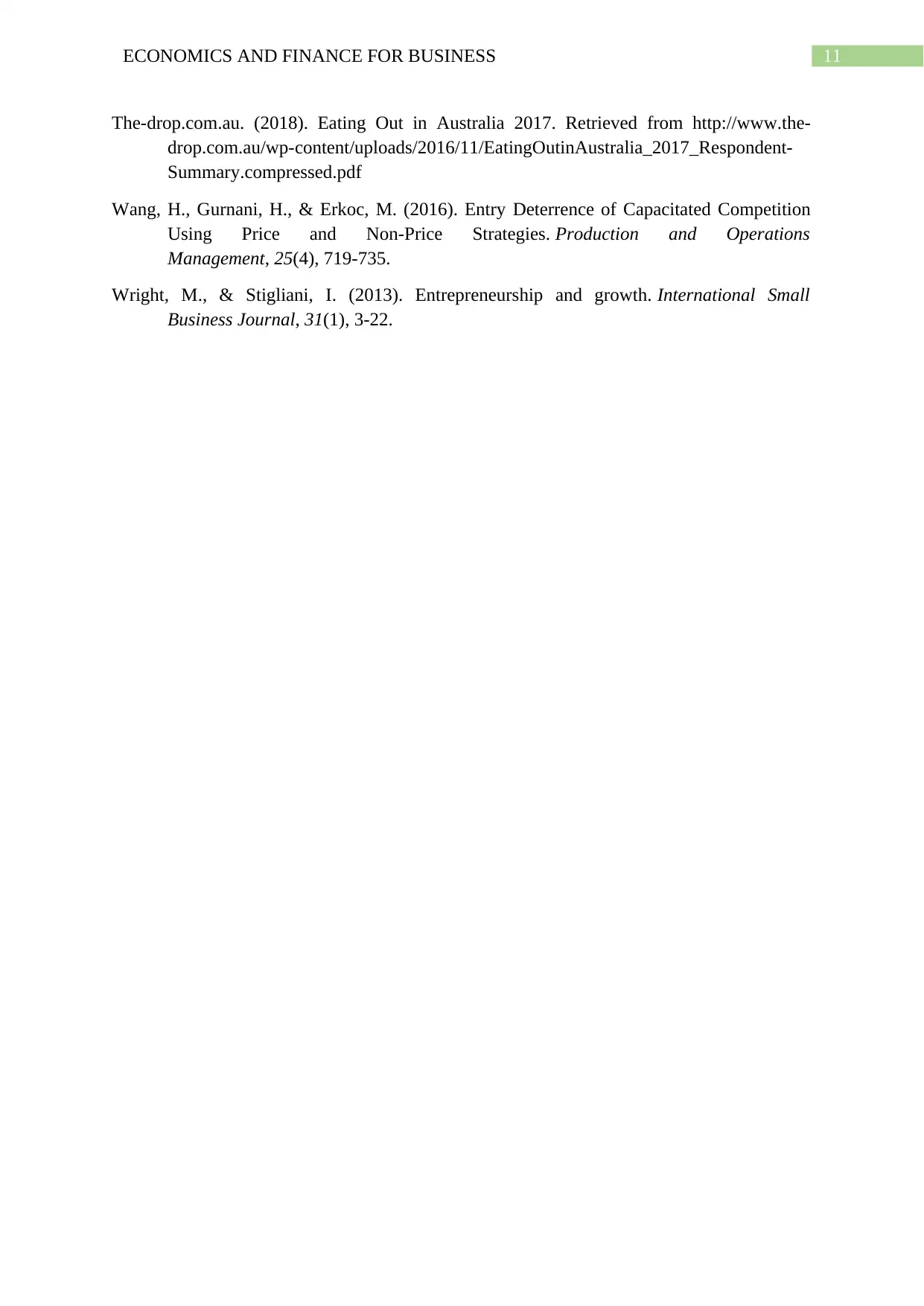
11ECONOMICS AND FINANCE FOR BUSINESS
The-drop.com.au. (2018). Eating Out in Australia 2017. Retrieved from http://www.the-
drop.com.au/wp-content/uploads/2016/11/EatingOutinAustralia_2017_Respondent-
Summary.compressed.pdf
Wang, H., Gurnani, H., & Erkoc, M. (2016). Entry Deterrence of Capacitated Competition
Using Price and Non‐Price Strategies. Production and Operations
Management, 25(4), 719-735.
Wright, M., & Stigliani, I. (2013). Entrepreneurship and growth. International Small
Business Journal, 31(1), 3-22.
The-drop.com.au. (2018). Eating Out in Australia 2017. Retrieved from http://www.the-
drop.com.au/wp-content/uploads/2016/11/EatingOutinAustralia_2017_Respondent-
Summary.compressed.pdf
Wang, H., Gurnani, H., & Erkoc, M. (2016). Entry Deterrence of Capacitated Competition
Using Price and Non‐Price Strategies. Production and Operations
Management, 25(4), 719-735.
Wright, M., & Stigliani, I. (2013). Entrepreneurship and growth. International Small
Business Journal, 31(1), 3-22.
1 out of 12
Related Documents
Your All-in-One AI-Powered Toolkit for Academic Success.
+13062052269
info@desklib.com
Available 24*7 on WhatsApp / Email
![[object Object]](/_next/static/media/star-bottom.7253800d.svg)
Unlock your academic potential
© 2024 | Zucol Services PVT LTD | All rights reserved.




